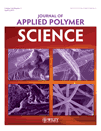Development and performance study of polypropylene/polyester bicomponent melt-blowns for filtration
Abstract
In this study, a new type of polypropylene (PP)/polyester (PET) bicomponent melt-blown (bi-MB) for filtration was developed through the melt-blowing process with raw materials of melt-blown (MB)-grade PP and PET chips. The structure, porosity, and filtration performance of the bi-MBs were tested through relevant instruments. The results show that the average fiber diameter in the bi-MBs was 2–3.5 μm, the average pore size was 12.3–15.6 μm, and the porosity was 90–94%. The results also show that the filtration efficiency of the bi-MBs was much higher than that of monocomponent PP MBs. It reached the highest value of 97.34% when the PP/PET ratio was 50/50 and could be used as high-performance filter media. © 2011 Wiley Periodicals, Inc. J Appl Polym Sci, 2012




